Everything From Fruit To Nuts
Friday we devoured the last few plump Evergreen Huckleberries – the end of our fruit and nut bounty this year. And just before the Huckleberries, a few volunteers tried the Medlar. (Medlar? Read Shakespeare to find out about this unusual fruit.) One volunteer thought it tasted like refried beans. Another tasted applesauce. I think it’s a combination of the two!
Let’s start at the beginning of the season. In order of appearance, the cast of characters:
Honeyberry (3 varieties), Cavendish and Cabot strawberry, raspberry (3 varieties), Illinois Everbearing Mulberry, blueberry (four varieties), Harrow Delight pear, Interlaken grapes, apples (William’s Pride, Honeycrisp, Fuji, Liberty, then N. Spy), Mirabelle de Nancy plum, Desert King fig, Precoce Migoule Chestnut, Izu Persimmon, Macrocarpa Medlar then, as the encore, the Evergreen Huckleberries.
for work parties
Please email to volunteer
freewayestatescommunityorchard@gmail
Overall, the harvest was very good. A bumper crop of blueberries – enough to donate to the Food Bank. (Blueberries and Mulberries are the volunteers’ favorite payment.)
The plum had to be hand-pollinated, But alas, a new plum with similar bloom time was planted last week, so the pollinators will do the work in the future.
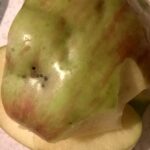 We footied some of the apples applied no netting, due to previous years’ lack of pest pressure. However, after 10 good years, the Honeycrisp and N. Spy got stung by the Apple Maggot Fly. We will have to net next year – an added chore. The other apple trees just had a little bit of earwig and coddling moth damage.
We footied some of the apples applied no netting, due to previous years’ lack of pest pressure. However, after 10 good years, the Honeycrisp and N. Spy got stung by the Apple Maggot Fly. We will have to net next year – an added chore. The other apple trees just had a little bit of earwig and coddling moth damage.
The Harrow delight pear did bring several pears to harvest, but not without a battle with the sawfly. The pear also carries Pacific Trellis Rust and shows cankers from scab.
We spend more time on pests and disease than we do on tree care. The rats love persimmon  and grapes. The Eastern Cottontail like to chew the bark of young trees and canes. The squirrels are partial to apples, taking a couple of bites out of each.
and grapes. The Eastern Cottontail like to chew the bark of young trees and canes. The squirrels are partial to apples, taking a couple of bites out of each.
Aluminum skirts work well to protect trees, and rabbits are kept at bay with a 14” fence of nearly any material. The clumsy black bird netting, the kind you get all tangled up in, well … no wonder the furry pests steer clear. Roof rats can jump vertically three feet from a 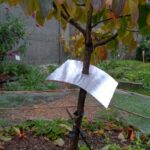 standing start; we got rid of low branches a long time ago.
standing start; we got rid of low branches a long time ago.
Powdered milk spray has been effective against powdery mildew of the grapes and the William’s Pride. Banding nearby tall trees with Tanglefoot in the fall has helped keep Winter Moth reproduction down. Two sprays of neem oil, one in winter and again at bud break seemed to really help the plum avoid it’s usual annual struggle with European scale, aphid, cankers, leaf rollers and, you name it.
We brought on two new persimmon, Hachiya, and Maekawa Jiro and, next year, we will graft a Sekel onto the Harrow Delight. We’ll also go out on a limb and try to propagate the Mulberry with two different techniques of layering.
My vote for the most trouble free, low labor fruit: Mulberry, Persimmon, Honeyberry, Chestnut, Medlar, Fig, and Elderberry.
Ruth

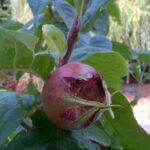
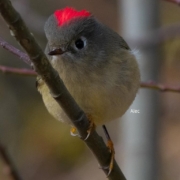
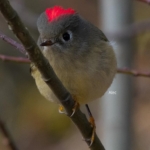
Leave a Reply
Want to join the discussion?Feel free to contribute!